Dear Hivers,
After discussing SEO in our first post, today we will start with the lesson.
We will be discussing:
- About titles
- About URL structures
These are the foundation of any post. Without a good title and a good URL structure, ranking on search engine becomes incredibly difficult.
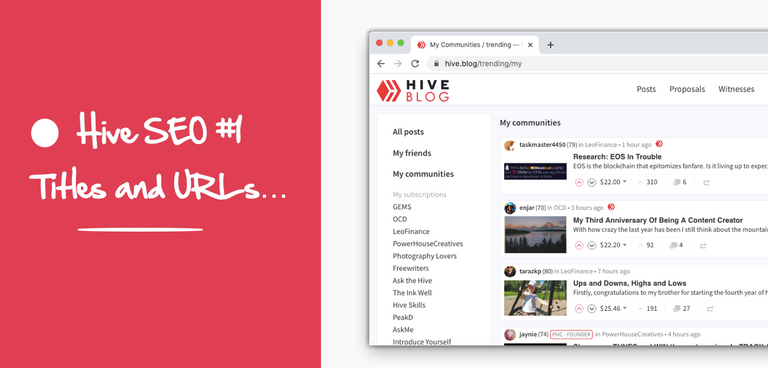
Before we go ahead, I am writing this tutorial as a timeless guide. You can apply these techniques in your next Hive post. And even apply them outside.
Whatever the case is, the goal is to share the best way to optimise your post. So let’s dive right into it:
Quick Look Into The Title + URL
Let’s take each part and discuss. If you are not familiar, check out this image with the title and URL:
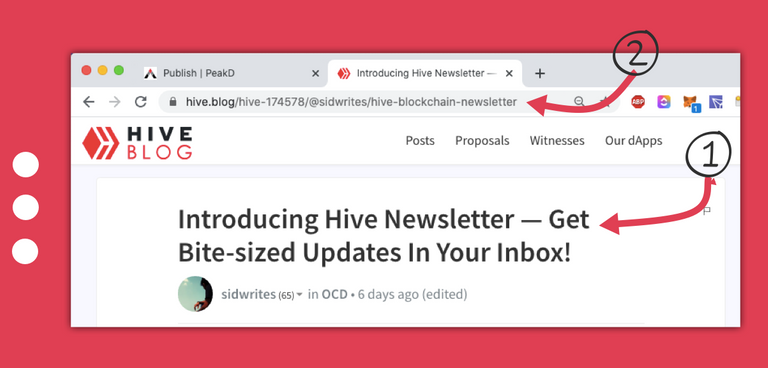
As you can see:
- #1 is the title.
- #2 is the URL.
Let's start with the title.
Section #1: Start With A Good Title
A title (also called as headline) is important for two reasons:
- It indicates your followers what the page is all about
- It indicates search engine what the page is all about
Let's take an example:
Imagine an article with “dot” as the title and nothing else. What do you think will happen? How would you feel?
And if the second article also has a dot. And the third. And fourth. It simply doesn't make sense, right?
Or take this one-word title as an example. It says "cars."
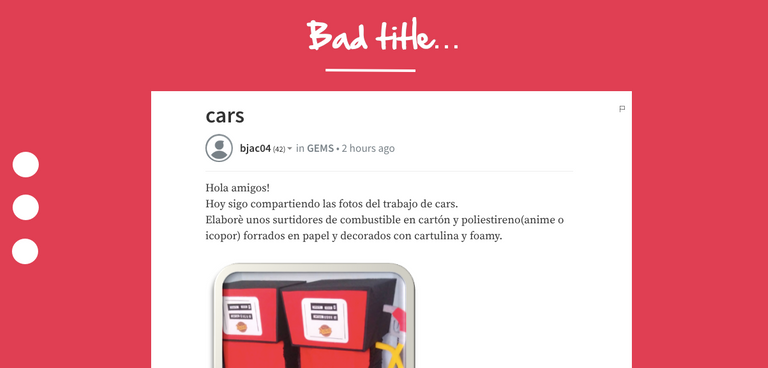
Here is another title that says "curse."
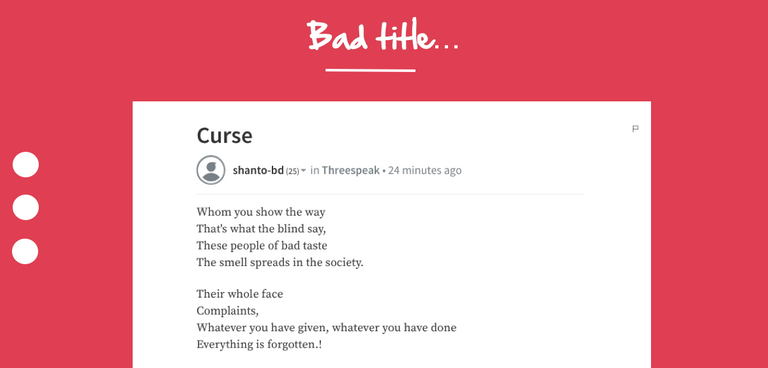
Or take this long title that goes on and on...

All these are bad titles. These are picked from here. When it comes to titles, I have noticed:
— Most people use 1 word
— Most people use 2-3 words.
— Most people use 15+ words
But the worst problem of all:
These titles are NOT clear. They do not convey the message.
- They do not indicate your followers what the page is all about
- They do not indicate search engine what the page is all about
Now let's take some good examples.
Here is one example title from a recent post: Best video games of all time.
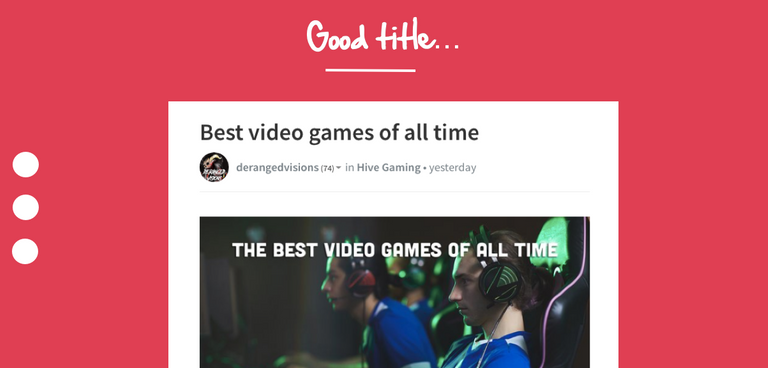
Here's another good example of a title:
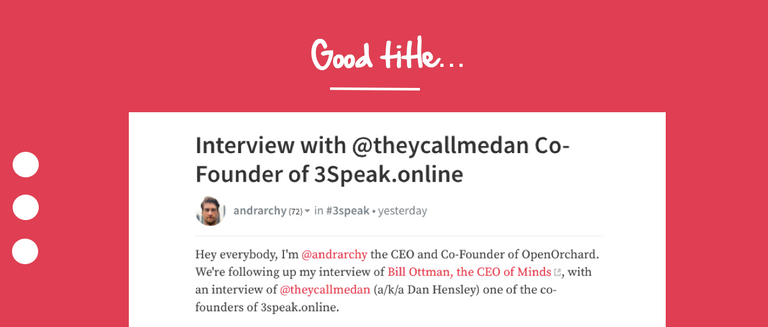
You might want to look into them once again. Because both the titles are complete and clear:
- They indicate followers what the page is all about
- They indicates search engine what the page is all about
Section #2: Let’s dive into the URL.
Treat URL as a human-readable text. A good URL makes everybody happy. In our case, we are talking about the post URL.
Post URL is also sometimes called:
- A slug
- A permalink
By default, Hive automatically generates the URL.
So if we take the title “Best video games of all time” then your URL will be:
hive.blog/@username/best-video-games-of-all-time/
There is nothing wrong with this URL but you can always optimise it:
For example:
- Remove excess word and make it /best-video-games/
- Change the word and make it /top-video-games/
The shorter the URL structure, the better it is.
Here’s why:
- Short URLs are easier to remember and can be shared on social media + email
- A short URL tells the search engine about the topic.
- A short URL improves the user experience.
The question is: How do you edit these URLs on Hive?
You have to use a front-end like @Peakd or @Esteemapp.
Here is an example:

In short: Let's say I use Peakd. Then I go to the editor and click the pencil icon. Now I change the URL and hit the tick button to save the new URL. If you try once, you will get it.
Note: When are you creating an URL:
- Do not use excessive words in the URL
- Do not use a generic term (page1) in the URL.
I don't see many people editing the URL as they are publishing through Hive.blog. More importantly, if the title is bad, the URL is also bad.
But let’s take an example of a good URL. Let me start with some of my URLs. I am always very picky:
URL Example:
- Take this 3Speak post
- URL is 3speak-features

- Take this Hive beginner's post
- URL is hive-tips-for-new-users

I simply used the "main" keywords I wanted to rank for. And if you search Google, the 3Speak Features article is on the top.
Let's combine both the title and the URL.
Here’s an example of a bad title and a bad URL:
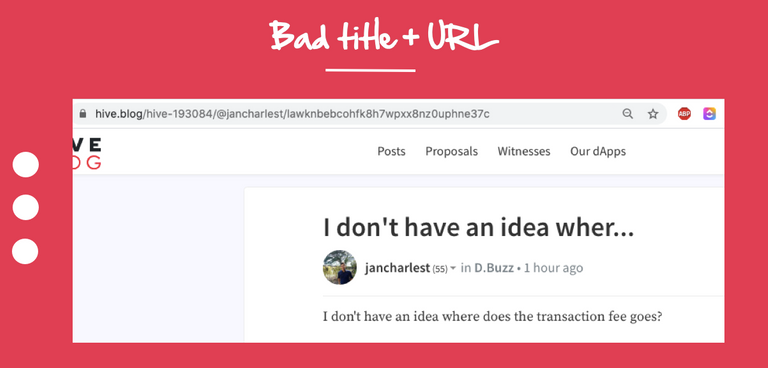
Can you guess why?
- Because the title is not complete.
- Because the URL structure is not readable.
This Week’s SEO Exercise
As a summary, we looked into the title and the URL. And then we saw why are they important.
After this, we saw some examples of bad and good titles. Then we moved onto URL structure — and how to change this structure.
Now we do some exercises. There are two:
Exercise 1: Look Into Others
- Continue reading articles on Hive.
- Look at the title
- Look at the URL
- Ask yourself: Why was it done this way?
Exercise 2: Look Into Your Post
- As you write your next post, take a step back and think about the title.
- If the title is short, make it long (8-14 words are good enough)
- If the title is long, make it short (8-14 words are good enough)
- Always make sure the title is simple and clear
- Once the title is ready, think about the URL structure
- Edit the URL structure (shorter the better)
The goal with both the exercise is simple: to make sure you are creating a SEO-friendly URL not just for search engine but also for humans to understand.
Cheers,
Sid
Liked this article? Feel free to comment and upvote and reblog.
Hadn't thought about URL structure for SEO. Good point!
Oh yes. The goal was to hit those points that most miss. URL structure is easily missed because a lot of people publish from Hive.blog.
And not from @Peakd or @ESteemapp.
We definitely need the URL editing feature across all the front-ends!
Url editing is something that I was wondering about as when you post to a community it has a horrible set of numbers and words as an identifier.
Exactly. So true!
I personally dislike those random strings.
The problem is, one can't edit 3Speak URLs. Something worth noting @threespeak and fixing in the future.
Adding URL editing feature on Hive.blog will be a game-changer as well. For now, we stick with other front-ends.
Great tips as for the URL it might be the ranking factor it once was but always great to try and have an exact match phrase in it!
Indeed. So true.
Right keywords has been the key.
Topics here are wide (photography, for example) with no clear titles. So the title has to be clear first. Hence I wrote the article this way. This title determines the keywords that goes into the URL.
I will be going into the "keyword phrases" soon! Hope this was helpful!
Cheers Sid, looking forward to more :)
Thanks @abh12345. Thought I would share one at a time... and overtime we will have a timeless guide! :)
Bro...thanks for this....id be applying it in my next post....I need to find you on discord
Haha! I am glad. I am on Discord with the same username.
Thank you for this interesting update and tips ! We will definitely apply it.
Cheers 🥂
Perfect. 🥂 Good times are here!
Thanks Sid, very well explained and a great reminder.
I am glad, Gtrussi. Thanks for going through this! :)
This is incredible. I must say thanks for giving this awesome piece, will start utilizing them.
I reblog so that my fellowers can gain from it as well.
That's so lovely of you!
Thank you! Truly appreciate it.
Oh wow, thanks for sharing these really neat tips, mate. My titles are normally short, though I tend to choose more eye-catching ones that try to stand out. I haven't really looked into the impact this has on SEO, however. It looks like my Medium re-posts take precedence. As for URLs, I never knew you could change it!
I noticed that Peakd does show up how the URL looks like - which is pretty great now that I think more on it - but I have never realised that it could be edited. So far though, it looks like the URL follows the title exactly. Stubborn as I am, I'm keen to try this out on my next post XD. Cheers :-)
Muchas gracias por la información no sabía hacerlo gracias